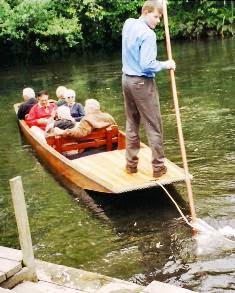Punt
Ride
 My
first and only punt ride was on the River Avon in Christchurch, New Zealand.
A
punt is a flat-bottomed long boat, square on both ends, and wide enough to seat
two abreast that is propelled with a long pole. Standing on a platform on the
stern of the punt, the pole is placed on the side and pushed from the bottom.
Punts are used on shallow rivers and originally were made to transport cargo.
Punting is quite a sport in certain parts of the world. Most often a punt can
carry six passengers. We leisurely floated down the river admiring the many
mansions and beautiful gardens along the way.
My
first and only punt ride was on the River Avon in Christchurch, New Zealand.
A
punt is a flat-bottomed long boat, square on both ends, and wide enough to seat
two abreast that is propelled with a long pole. Standing on a platform on the
stern of the punt, the pole is placed on the side and pushed from the bottom.
Punts are used on shallow rivers and originally were made to transport cargo.
Punting is quite a sport in certain parts of the world. Most often a punt can
carry six passengers. We leisurely floated down the river admiring the many
mansions and beautiful gardens along the way.
It
was a new and fun experience.
A
Dining Tram
I’ve
had meals in the dining car of trains but had never had a meal on a tram until
I was in New Zealand the second time. We boarded the tram at dinnertime to find
the tables set with white linen. As we circled the city several times, tux clad
waiters served a delicious lamb meal with all the trimmings, including wine. It
was great fun. I’ve heard about similar experiences in a few other cities so if
you ever are where one exists it will provide a unique dining experience and fun time.
Orphaned
Kangaroo
 We were
surprised when we walked into a store on Kangaroo Island, Australia to see a
baby kangaroo swaddled in a sling hanging on a coat rack. The owner told us
that Mama had been killed
by a car, so they’d been raising the little one. She was wrapped in the sack because it confined her like she was in
her mama’s pouch. We
all took turns holding and loving the baby while cameras clicked away.
We were
surprised when we walked into a store on Kangaroo Island, Australia to see a
baby kangaroo swaddled in a sling hanging on a coat rack. The owner told us
that Mama had been killed
by a car, so they’d been raising the little one. She was wrapped in the sack because it confined her like she was in
her mama’s pouch. We
all took turns holding and loving the baby while cameras clicked away.
A
Flightless Airline?
We
arrived at Kangaroo Island from Adelaide by ferry over a rather rough channel.
But we returned on Emu Airlines---remember the emu does not fly, so why would anyone
name an airline after the animal? We didn’t think too much about being weighed
with our packs, but it was a little disconcerting to watch the pilot load out
packs in the wing and then climb up
on it and crawl through a window to his seat! It was a short flight, but I was
happy to be on the ground and off the small 6-8 seat plane.
Koalas
in the Wild
 While
travelling around the island we
spotted many koalas up in trees, and a
couple of moms even were carrying a baby in her pouch. It is a bit unusual to see the nocturnal animals during
the day. Daytime is when they usually curl up in the fork of tree branches and
sleep.
We stopped to admire several doing just that when suddenly a baby started crawling down from a tree. When
on the ground the baby walked several feet to where a gal was standing and started to climb up her leg!
While
travelling around the island we
spotted many koalas up in trees, and a
couple of moms even were carrying a baby in her pouch. It is a bit unusual to see the nocturnal animals during
the day. Daytime is when they usually curl up in the fork of tree branches and
sleep.
We stopped to admire several doing just that when suddenly a baby started crawling down from a tree. When
on the ground the baby walked several feet to where a gal was standing and started to climb up her leg!
Her pants were almost the exact color of the
tree trunks, and she figured the little koala thought her white shoes were
rocks. The driver wiggled him off her leg, but not before he left a puncture
wound in her lower leg. What an adventure!
Lots of fun times down under!

